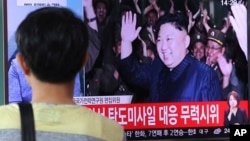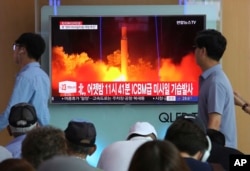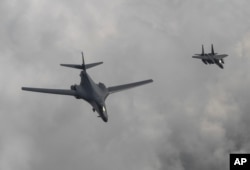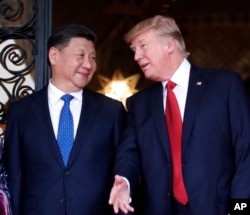North Korea said Sunday its latest test missile, deemed by weapons experts as capable of reaching the U.S. mainland, was a "stern warning" to Washington against a new round of sanctions aimed at Pyongyang.
The North Korean Foreign Ministry said Washington should "wake up from the foolish dream of doing any harm" to the reclusive communist nation.
Pyongyang's statements came hours after the U.S. Air Force flew two B-1B bombers over the Korean Peninsula, accompanied by South Korean and Japanese jet fighters, as a show of strength against North Korean threats.
Meanwhile, the U.S. Missile Defense Agency said it conducted its 15th successful shoot-down of a medium-range ballistic missile in 15 tests of its Terminal High Altitude Area Defense system. The target ballistic missile was launched from a fighter jet over the Pacific Ocean, but the military said it was detected, tracked and intercepted by the defense system located in Alaska.
Military Defense Agency chief Lieutenant General Sam Greaves said data collected from the test would improve the U.S.'s "ability to stay ahead of the evolving threat."
The U.S. Pacific Command said its fly-over conducted with South Korean and Japanese jet fighters was in "direct response" to North Korea's "escalatory launch" of intercontinental ballistic missiles on July 3 and last Friday.
"North Korea remains the most urgent threat to regional stability," said General Terrence O'Shaughnessy, U.S. Pacific Air Forces commander. "Diplomacy remains the lead; however, we have a responsibility to our allies and our nation to showcase our unwavering commitment while planning for the worse-case scenario. If called upon, we are ready to respond with rapid, lethal, and overwhelming force at a time and place of our choosing."
The 10-hour joint forces mission began at Andersen Air Force Base in Guam. U.S. Air Force bomber jets were joined by two Japanese F-2 fighter jets in Japanese airspace. The U.S. bombers then flew over the Korean Peninsula and were accompanied by four South Korea fighter jets. The U.S. bombers also did a low-pass over South Korea's Osan Air Base, before returning to Guam.
U.S. President Donald Trump again criticized China for failing to stop North Korea's ballistic missile and nuclear weapons programs.
Following Friday's launch of an intercontinental ballistic missile that landed west of Japan, Trump singled out China for blame on Saturday evening, saying Beijing could "easily solve this problem.
"I am very disappointed in China," Trump wrote on his Twitter account. "Our foolish past leaders have allowed them to make hundreds of billions of dollars a year in trade, yet they do NOTHING for us with North Korea, just talk. We will no longer allow this to continue."
Trump's remarks echoed those made by Secretary of State Rex Tillerson, who released a statement that blamed both China and Russia for North Korea's continued violations of U.N. Security Council resolutions.
"As the principal economic enablers of North Korea's nuclear weapon and ballistic missile development program, China and Russia bear unique and special responsibility for this growing threat to regional and global stability," Tillerson said.
In April, Trump praised his first meeting with China's President Xi Jinping, later telling reporters that Xi had agreed to suspend coal and fuel shipments to pressure North Korea to stop its belligerent behavior. However, since then, the North has continued to threaten its neighbors and the United States, and Trump has grown more critical of Beijing.
Even though the North Korean missile landed west of Japan, experts said it would be powerful enough to reach much of the U.S. mainland. North Korea's official news agency said leader Kim Jong Un boasted that the latest test was “meant to send a grave warning to the U.S."
China condemned the launch, while Japan, South Korea and the U.S. vowed to work together on a new Security Council measure aimed at curbing North Korea’s nuclear ambitions.
At the same time, the U.S. Congress has overwhelmingly approved new sanctions aimed at North Korea, Russia and Iran, a measure the White House says Trump plans to sign into law.












